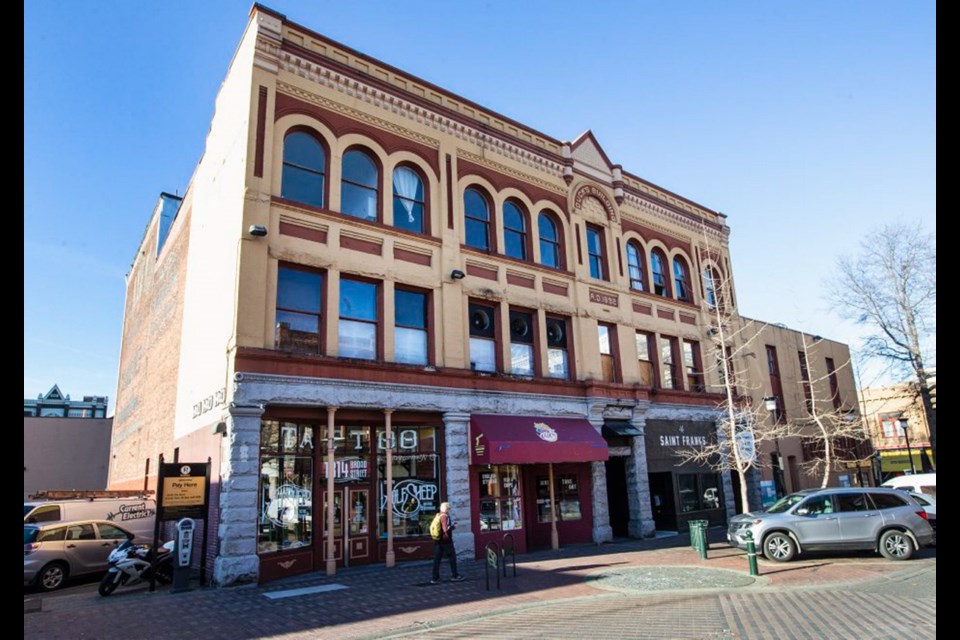A controversial proposal to demolish significant parts of two heritage buildings in Victoria’s Old Town and replace them with a 139-room hotel appears headed for a public hearing.
City councillors agreed at committee of the whole Thursday to let residents have a say on plans to develop the 127-year-old Duck’s Building and the adjacent Duck’s Carriage Factory Building, also known as the Canada Hotel, which dates to the 1870s.
The vote was 4-2 with two councillors absent, so it’s uncertain whether the motion to go to a public hearing will receive final approval at a council meeting next week.
The properties are among those bequeathed to the University of Victoria by the late Michael Williams, businessman, developer and the man behind Swan’s Hotel and Brew Pub.
UVic Properties has partnered with Chard Development on the proposal to retain the facade, rear wall and portions of the side walls of the Duck’s Building at 1314-1324 Broad Street, and demolish all but an original rock wall of the former Duck’s Carriage Factory next door at 615-625 Johnson St.
The resulting hotel would stretch nearly a full block along Broad Street and feature two infill buildings on either side of the rehabilitated Duck’s Building, built in 1892.
UVic Properties would retain ownership of the land and receive annual revenue through a 99-year lease.
David Chard of Chard Development said the project would protect and restore the most important elements of the buildings, while bringing new life to Broad Street and downtown. “I think that we will help to reinvigorate Old Town,” he said.
Opponents, however, worry the project would lead to other developments that preserve only the facades of Victoria’s heritage buildings. “You lose the authenticity of the buildings,” said Pamela Madoff, heritage advocate and a former city councillor.
“It starts to look a little bit like a theme park,” Madoff said.
In the case of the Carriage Factory/Canada Hotel building, she questioned whether another developer would have taken a different approach and rehabilitated the structure.
“If we start allowing heritage buildings in Old Town to be demolished because it’s convenient, then what happens to the integrity of our program and the integrity of Old Town?”
Ian Sutherland, who chairs the Downtown Residents Association’s land-use committee, raised additional concerns about the project’s size and density.
“I don’t think people realize just how big the additions are to this building and the additions are going to completely overwhelm the original building,” he said.
Sutherland noted that other buildings have been restored without resorting to demolition and increases in density.
“I own two of them that were bought in poor condition and [are] heritage-designated buildings in the downtown,” he said. “I managed to completely rehabilitate both of them. I bought them on the open market. I didn’t inherit them. … They produce a good return for me.”
Chard countered that earlier projects were done under a more relaxed B.C. Building Code. He said the strict new requirements make it too onerous and costly to preserve the entire Duck’s Building and still ensure safety in the event of an earthquake.
“The new seismic code really means that we have to re-construct everything on the inside, because the existing timber frame is just not strong enough to support the new seismic requirements,” he said.
As for the Canada Hotel building, Chard said it has gone through “completely unsympathetic restorations” over the years, leaving little of the original structure except the rear rock wall built in 1874. “That has significant heritage value and that is what we’re keeping,” he said. The project includes plans to unveil and illuminate more of the rubble wall behind the hotel and make it a feature element of a rejuvenated “Duck’s Alley.”
In addition, the facade and walls of the Duck’s Building will be repointed and restored to their original appearance. “It’s a very massive heritage restoration that we’re doing.”
The proposal won approval from the city’s heritage advisory and advisory design panels as well as a recommendation from city staff.
“The proposal includes significant enhancements to the front facade of the Duck’s Building while providing an interior structure that will ensure the life safety of building occupants in the event of a major earthquake,” a staff report concluded. “The development conserves the form and scale of the Duck’s Building without overwhelming it.”
The Greater Victoria Chamber of Commerce wrote in support of the project, noting it would be the first purpose-built hotel in the city in 15 years. “Chard’s commitment to pursuing this redevelopment in a manner that is respectful of the site’s heritage — rehabilitating the existing Duck’s Building and the Duck’s Carriage Factory rubble wall — will make this a destination that truly reflects the city’s past while encouraging its future growth,” wrote Catherine Holt, chief executive officer.
J.C. Scott, who was an architectural adviser to Michael Williams, offered “qualified support” for the project in an interview.
He believes Williams would have approved of the 99-year lease, the preservation of the rubble wall and the heritage restoration of the Duck’s Building, given the seismic challenges. He’s less convinced that Williams would have supported increased density and height in Old Town.
“I think the project will go ahead and should go ahead,” Scott said. “But I’m afraid of setting precedents for greater height, density, etc.”



